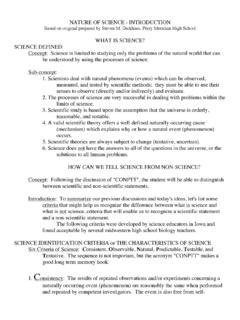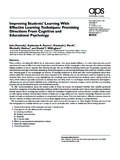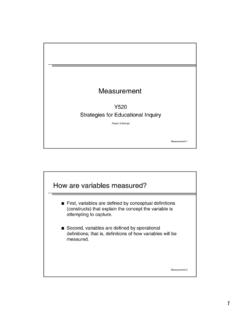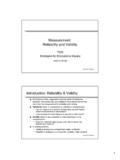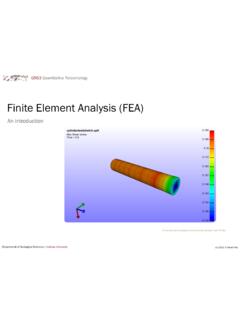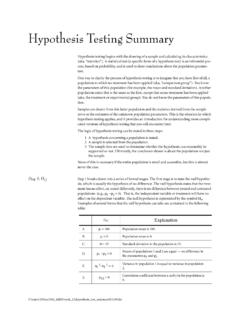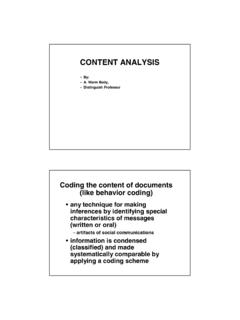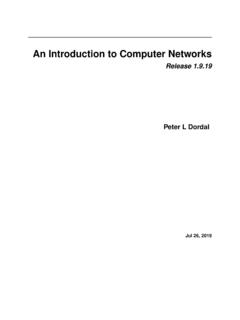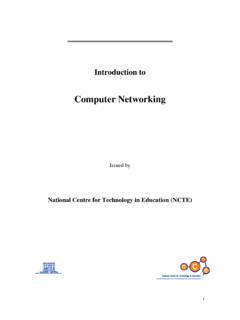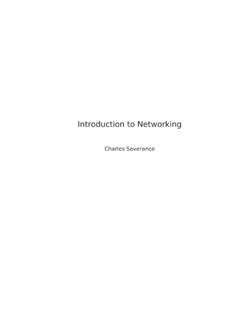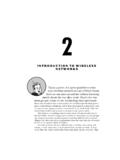Transcription of Introduction to Computer Networks
1 1 Introduction to Computer NetworksChen YuIndiana UniversityBasic Building Blocks for Computer Networks Nodes PC, server, special-purpose hardware, sensors Switches Links: Twisted pair, coaxial cable, optical fiber, phone line, wireless radio channels network : two or most hosts connected by links/switchesAddressing and Routing Address: something that identifies a nodeoften a unique byte string. Routing: find a route (path) to the destination node based on its address. Types of traffic/addressing Unicast: to a single destination node. Broadcast: to all nodes on the network . Multicast: to some subnet of nodes on the Protocol A network protocol describes how communication entities (sender/receiver) should interact to accomplish a networking task. Format, order of messages sent and received Actions taken on message transmission, receipt Protocol define interface, not implementationsAllow two sides of a communication task to be independently designed / implemented.
2 An example A human protocolPerson A Person B hihiGot the time?3:30 A Computer protocolcomputer A Computer B Build a connection?responseGet <file> network Layers Separation of network functions /features allow independent design and implementation. Layering is a vertical separation of network functions / features. Hidden the complexity: each layer interface hides complexity in this layer and layers below. 3 Internet Architecture Bottom-up: Physical: electromagnetic signals on the wire. Link: data transfer between neighboring network elements. Ethernetencoding, framing, error correction network : host-to-host connectivity. IP routing and addressing Transport: host-to-host data transportreliable data transport, congestion control, flow control. TCP/UDP Application: anything you want to do on Computer Networks .
3 HTTP, FTP, SMTPP rotocols for the Internet Architecture Difference between layers, protocols, protocol implementations. Socket Programming Socket: the interface between application processes and underlying networking systems. 4 Socket Programming Socket: an OS interface into which application processes can communicate with remote application process. Two types of transport services via socket APIs: Connection-oriented byte stream (TCP) Connectionless datagram (UDP)Port Numbers Multiple sockets might exist in each host A port number identifies each such socket in each host Usually, port numbers ranging from 0 to 1023 are called well-known port numbers and are restricted. TCP socket At the server: server must have created socket (door) that welcomes client s contactserver process must first be running Client contacts server by:Creating client-local TCP socketSpecifying IP address, port number of the server socketWhen client creates sockets: client TCP establishes connection to server TCP.
4 When contacted by client:server TCP creates a new connection socket for communicating with the client, which allows server to talk with multiple clients. 5 Berkeley Sockets Operations:fd = socket(): create the socketbind(fd,port): binds socket to local (fd,port): establish a connection to a remote portsend(), recv(), write(), read(): operations for sending and receiving dataclose(fd) Association The 5-tuple that completely specifies the two processes that make us a connection.{protocol, local-addr, local-process, foreign-addr, foreign-process} Server-Client Model6 UDP Socket UDP: connectionlessno handshakingsender explicitly attaches IP address and port of destination to each datagram. Datagram-orientedTCP Segment StructureProtocols vs. Implementation They specify: Syntax and semantics of messages exchanged.
5 Rules for when and how processes send & respond to messages. They don t specify the implementation: Programming languages, data structures The goal:components implemented independently can inter-operate with each other as long as they follow the protocol specification. 7 network Applications and Application-layer Protocols network applications: running in end systems (hosts) distributed, communicating using network . use communication services provided by lower layer protocols (TCP, UDP). Application-Layer Protocolsdefine interface between application entities. network Applications Some commonplace applications Web and HTTP FTP, telnet and ssh E-mail: SMTP, POP3, IMAP DNS Distributed file sharingHTTP and web HTTP: hypertext transfer protocol Web: the application using HTTP protocol Client/Server model Client: browser that requests, receives, and displays web objects Server: web server sends objects in response to requests8 HTTP and Web HTTP specifies Types of messages exchanged, request & response messages Syntax of message types: what fields in messages & how fields are delineated.
6 Semantics of the fields, ie. Meaning of information Rules for when and how processes send & respond to messages. Web client and server can inter-operate as long as they follow HTTP Web client (brower): IE, Firefox Web server: Apache, MS IISE lectronic Mail Two types of entities: Mail serversmailbox contains incoming messages for usersmessage queue of outgoing (to be sent) mail messages User agentscompose, edit, read mail messages. pine, Mail Two types of protocols: Mail transfer protocolfrom sender agent to the receiver s mail server (SMTP simple mail transfer protocol) Mail access protocolthe receiver pulls mails from server to agent. POP3, IMAP, HTTP 9 Example You use your PC to compose a message with Bob s address. Your PC sends the message to her mail server through SMTP; the message is placed in a message queue.
7 Your mail server sends message to Bob s mail server through SMTP. Bob s mail server places the message in Bob s mailbox Bob invokes his user agent to read the message. SMTP interaction between mail servers S: 220 Postfix C: HELO S: 250 Hello C: MAIL S: 250 Ok C: RCPT S: 250 Ok C: DATA S: 354 End data with <CR> <LF>.<CR> <LF> C: Subject: test message C: From: C: To: C: C: Hello, C: This is a test. C: Goodbye. C: . S: 250 Ok: queued as 12345 C: QUIT S: 221 Bye Example telnet servername 25 See 220 reply from the server Enter hello, mail from, rcpt to, dataThis allows you Send email without using a normal email client ..10 Mail Access Protocols SMTP: delivery/storage to the receiver s server Mail access protocol: retrieve from server POP: Post Office Protocol IMAP: Internet Mail Access Protocol HTTP: Hotmail, yahoo!
8 MailDNS: Domain Name System People: multiple identifiersSSN unique, for tax reportingName Human friendly, easy to remember Internet hosts: IP address used for addressing, routing on the Internet name : human friendly. Question: Map between IP addresses and names? DNS query: find the IP address for a given namecore function for Internet applications ssh vs. ssh : decentralized Distributed database implemented with collaboration of many name servers distributed all over the network . No server has all name-to-IP address mappings. Why not centralize DNS? What if massively replicating it?11 Query Recursive Query:puts the burden of name resolution on the contacted name server. Iterative Query:contacted server replies with name of server to contact I don t know this name, but ask this server DNS Caching Once a name is learned by the name server, it caches mapping so the next query for the same name can be answered directly.
9 This can happen at any step of the name lookup. Cache entries timeout (disappear) after some time ( two days). Timeout is necessary because the mapping can change. DNS Scalability & Reliability ScalabilityPoor scalability at few root name servers ReliabilityProblems at a root server can cause big troubles. too many replicated root name servers would make it difficult to synchronize File sharing Napster: central index Gnutella (query flooding) non-hierarchical, equal statusPeer-to-Peer Networks Fundamental advantage of p2p networksbetter scalability no performance robustness more tolerant to random failures, intentional attaches. Challenge: peer coordination without complete global knowledge. Peer A pure peer-to-peer network does not have the notion of clients or servers, but only equal peernode that simultaneously function as both "clients" and "servers" to the other nodes on the network .
10 13 Keyword search Users input a few keywords, the system returns a list of documents matching the keywords. google Google maintains a central search index:a search index contains a list of all searchable words, each of which contains a list of documents relevant to the word. interaction document lists for multiple-word queries. Scalability?Robustness? Peer-to-Peer Keyword Search Splitting the central search index into smaller pieces and distributing them in peer-to-peer fashion. Challenge: make them work collaboratively to achieve similar speed and quality of search. Two solutions Splitting based on keywordssplit the index database to many pieces based on keywords and distribute them to many nodes in the network . Split based on documents 14 Putting them together Split based on keywordsweakness: transferring large data segments for multiple keyword queries.
